基于TI公司的PGA400-Q1、TPS7B82-Q1 精密电流检测参考设计TIDA-03040
 252
252
 拍明
拍明
原标题:TI PGA400-Q1汽车±500A精密电流检测参考设计TIDA-03040
TI公司的PGA400-Q1是用于压力传感器,应力表和电容检测元件的接口器件,集成了直接连接到检测元件的模拟前端(AFE)以及电压稳压器和振荡器,还包括有Sigma-Delta ADC,8051 WARP核微处理器和8KB OTP存储器,89B EEPROM和256B 数据SRAM.主要用在压力传感器信号调理,水平传感器信号调理和湿度传感器信号调理.本文介绍了PGA400-Q1主要特性,功能框图以及汽车±500A精密电流检测参考设计TIDA-03040主要特性,框图和系统指标,框图和电路图,材料清单.
The PGA400-Q1 device is an interface device forpiezoresistive, strain gauge, and capacitive-senseelements. The device incorporates the analog frontend (AFE) that directly connects to the sense elementand has voltage regulators and an oscillator. The device also includes a sigma-delta analog-to-digitalconverter (ADC), 8051 WARP core microprocessor,and OTP memory. Sensor compensation algorithmscan be implemented in software. The PGA400-Q1device also includes two digital-to-analog converter(DAC) outputs.
描述
PGA400-Q1 是一个针对压阻、应变仪和电容感测元件的器件接口。 此器件组装有直接连接至传感元件的模拟前端并带有电压稳压器和振荡器。 此器件还包括三角积分模数转换器、8051 WARP 核心微处理器和 OTP 内存。 传感器补偿算法可由软件执行。 PGA400-Q1 还包括 2 个 DAC 输出。
特性
模拟特性
针对
阻性桥式传感器的模拟前端
针对
电容传感器的自振荡解调器
片上温度传感器
可编程增益
用于信号信道的 16位、1MHz 三角积分模数
转换器
用于温度信道的 10位三角积分模数
转换器
两个 12 位数模转换器 (DAC) 输出
数字特性
微控制器内核 10MHz 8051 WARP 核心 每个指令周期 2 个时钟片载振荡器
内存8KB 一次性可编程 (OTP) 内存 89 字节 EEPROM 256 字节数据 SRAM
外设特性
串行外设接口 (SPI™)
内置集成电路 (I2C™)
一线制接口
两个输入捕捉端口
两个输出比较端口
软件看门狗装置定时器
振荡器看门狗装置
电源管理控制
模拟低压检测
一般特性
车用温度范围:–40°C 至 125°C
电源:4.5V 至 5.5V 可运行,-5.5V 至 16V 绝对最大值
符合 AEC-Q100 标准
PGA400-Q1主要特性:
1• Analog Features
– Analog Front-End for Resistive Bridge Sensors
– Self-Oscillating Demodulator for CapacitiveSensors
– On-Chip Temperature Sensor
– Programmable Gain
– 16-Bit, 1-MHz Sigma-Delta Analog-to-DigitalConverter for Signal Channel
– 10-Bit Sigma-Delta Analog-to-Digital Converterfor Temperature Channel
– Two 12-Bit Digital-to-Analog Outputs
• Digital Features
– Microcontroller Core
– 10-MHz 8051 WARP Core
– 2 Clocks Per Instruction Cycle
– On-Chip Oscillator
– Memory
– 8KB of OTP Memory
– 89 Bytes of EEPROM
– 256 Bytes Data SRAM
• Peripheral Features
– Serial Peripheral Interface (SPI)
– Inter-Integrated Circuit (I2C)
– One-Wire Interface (OWI)
– Two Input Capture Ports
– Two Output Compare Ports
– Software Watchdog Timer
– Oscillator Watchdog
– Power Management Control
– Analog Low-Voltage Detect
• General Features
– AEC-Q100 Qualified With the FollowingResults:
– Device Temperature Grade 1: –40°C to+125°C Ambient Operating Temperature
– Device HBM ESD Classification Level 2
– Device HBM ESD Classification Level C3B
– Power Supply: 4.5-V to 5.5-V Operational,–5.5-V to 16-V Absolute Maximum
PGA400-Q1应用:
Pressure Sensor-Signal Conditioning
Level Sensor-Signal Conditioning
Humidity Sensor-Signal Conditioning
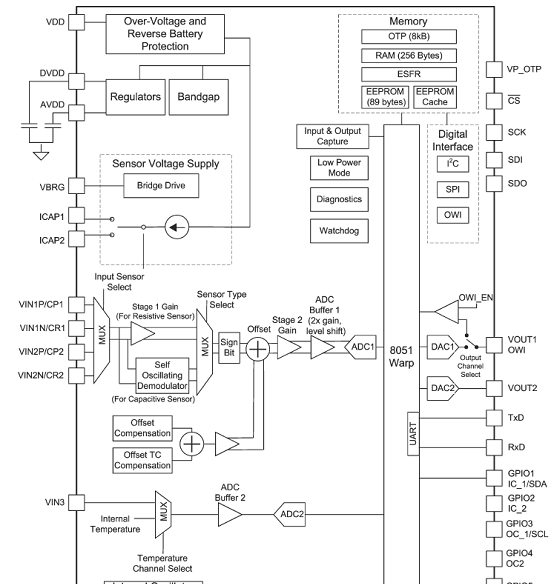
图1.PGA400-Q1功能框图
汽车±500A精密电流检测参考设计TIDA-03040
This shunt-based current sensor reference design provides an accuracy of < 0.2% FSR over a temperature range of -40°C to +125°C. Precision current sensing is essential in a number of automotive applications, including battery management systems, motor currents, and others. Generally, nonlinearity, temperature drift, shunt tolerances in these locations can cause poor accuracy results. This design solves these problems by using TI’s current shunt monitors and signal conditioners (INA240, PGA400-Q1).
Vehicles are becoming more electrified—not just electric vehicles or hybrid-electric vehicles, but evengasoline and diesel powered machines. It becomes more critical to accurately monitor the currentconsumed to ensure performance as well as long-term reliability. Current sensing is critical for essentialoperations such as motor control, DC/DC, battery monitoring, and so on. The performance of any currentsensor solution mainly depends on the device specifications such as accuracy, bandwidth, linearity,precision, or efficiency. Designing a system that satisfies all the required specification is a challenging task. This TI Design shows how to handle some of these parameters: accuracy, linearity, and precision.
Current can be measured in many ways such as Faraday’s induction law, Ohm’s law, Lorentz force law,magneto-resistance effect, and the magnetic saturation. This reference design is based on Ohm’s lawbased shunt current sensing. Each technology has its own advantages and disadvantages, depending onthe place of use every customer has his or her own preference of which topology to choose. Whendesigning the current sensor, it is essential to choose where exactly current is being measured, its currentmeasurement range, its low side or high side, and whether it is uni- or bidirectional; the topology anddesign can be defined based on these parameters. As it becomes a new trend, 48 V implies the currentsensor requires a larger span on current measurement range. By considering these prameters, thepresent reference design topology is defined as follows:
• Measurement range: ±500 A, implies bidirectional
• Low side or high side (configurable)
• Accuracy: 0.2% FSR
• Temperature range: –40℃ to 125℃
To elaborate these specifications: a ±500-A current is made to pass through the 100-μΩ shunt. Across theshunt there is a noticeable amount of voltage drops. Using TI’s current shunt monitor (INA240 (1)), thissmall amount of voltage drop is measured and given to the PGA400-Q1 for linearity and compensationalgorithms to create a ratio-metric voltage in between 0.5 to 4.5 V.
汽车±500A精密电流检测参考设计TIDA-03040主要特性:
Accuracy of 0.2% FSR, over temperature (-40℃ to 125℃)
Suitable for ±500A, high/low-side current sensing
Compensated for temperature and non-linearity (second order temperature and linearity compensation algorithm)
Protection against harness faults (overvoltage, reverse polarity, input/output signal protection)
Electromagnetic interference (EMI) protection
参考设计TIDA-03040应用:
• 48-V or 12-V Battery Management Systems
• Motor Control Systems
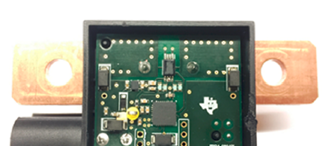
图2.汽车±500A精密电流检测参考设计TIDA-03040外形图
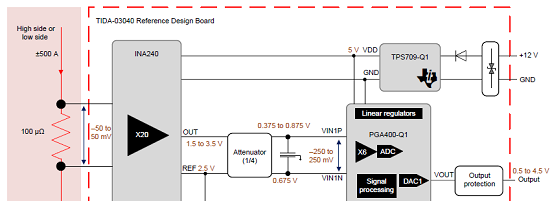
图3.参考设计TIDA-03040功能框图
参考设计TIDA-03040系统指标:
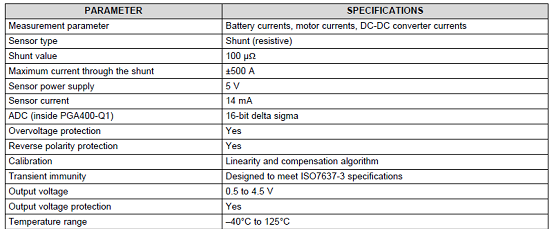
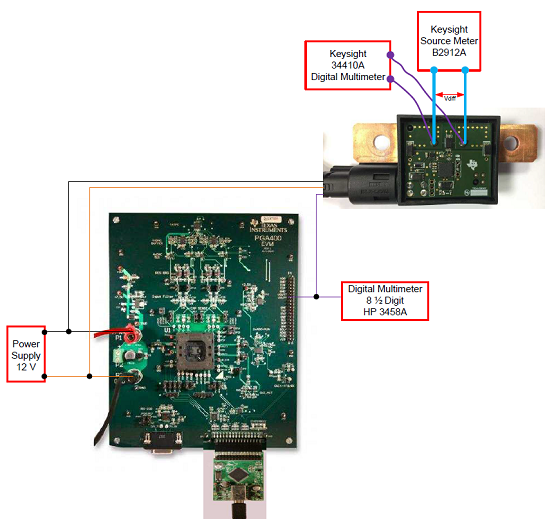
图4.参考设计TIDA-03040和PGA400-Q1 EVM的校准连接图
参考设计TIDA-03040材料清单:

TI 器件
| 器件型号 | 名称 | 产品系列 |
|---|---|---|
| INA240 | 电压输出、高/低侧测量、双向零漂移系列 | 电流感应放大器 |
| PGA400-Q1 | 具有微控制器的汽车类可编程传感器信号调节器 | 专用传感器 |
| TPS709-Q1 | 具有反向电流保护的汽车用 150mA、30V 超低 IQ、宽输入 LDO | 能源管理 |
INA240
描述
INA240 器件是一款电压输出、电流检测放大器,具有增强型 PWM 抑制功能,可在独立于电源电压的 –4V 至 80V 宽共模电压范围内检测分流器电阻上的压降。负共模电压允许器件的工作电压低于接地电压,从而适应典型螺线管应用 的反激周期低功耗是一个关键问题。增强型 PWM 抑制功能可为使用脉宽调制 (PWM) 信号的系统(例如,电机驱动和螺线管控制系统)中的较大共模瞬变 (ΔV/Δt) 提供高水平的抑制。凭借该功能,可精确测量电流,而不会使输出电压产生较大的瞬变及相应的恢复纹波。
该器件由 2.7V 至 5.5V 的单电源供电运行,消耗的最大电源电流为 2.4 mA。共有四种固定增益可供选用:20V/V、50V/V、100V/V 和 200V/V。该系列器件采用零温漂架构,偏移较低,因此能够在分流器上的最大压降低至 10mV(满量程)的情况下进行电流检测。所有版本均具有扩展额定工作温度范围(-40°C 至 +125°C),并且采用 8 引脚 TSSOP 和 8 引脚 SOIC 封装。
特性
增强型 PWM 抑制功能
出色的共模抑制比 (CMRR):
132dB DC CMRR
93dB AC CMRR(50kHz 时)
宽共模电压范围:-4V 至 80V
精度:
增益:
增益误差:0.20%(最大值)
增益温漂:2.5ppm/°C(最大值)
失调电压:
偏移电压:±25µV(最大值)
温漂:250nV/°C(最大值)
可用的增益:
INA240A1:20V/V
INA240A2:50V/V
INA240A3:100V/V
INA240A4:200V/V
静态电流:2.4mA(最大值)
PGA400-Q1
描述
PGA400-Q1 是一个针对压阻、应变仪和电容感测元件的器件接口。 此器件组装有直接连接至传感元件的模拟前端并带有电压稳压器和振荡器。 此器件还包括三角积分模数转换器、8051 WARP 核心微处理器和 OTP 内存。 传感器补偿算法可由软件执行。 PGA400-Q1 还包括 2 个 DAC 输出。
特性
模拟特性
针对
阻性桥式传感器的模拟前端
针对
电容传感器的自振荡解调器
片上温度传感器
可编程增益
用于信号信道的 16位、1MHz 三角积分模数
转换器
用于温度信道的 10位三角积分模数
转换器
两个 12 位数模转换器 (DAC) 输出
数字特性
微控制器内核 10MHz 8051 WARP 核心 每个指令周期 2 个时钟片载振荡器
内存8KB 一次性可编程 (OTP) 内存 89 字节 EEPROM 256 字节数据 SRAM
外设特性
串行外设接口 (SPI™)
内置集成电路 (I2C™)
一线制接口
两个输入捕捉端口
两个输出比较端口
软件看门狗装置定时器
振荡器看门狗装置
电源管理控制
模拟低压检测
一般特性
车用温度范围:–40°C 至 125°C
电源:4.5V 至 5.5V 可运行,-5.5V 至 16V 绝对最大值
符合 AEC-Q100 标准
晶圆级芯片封装 (WCSP)-36
TPS709-Q1
描述
在汽车电池连接 应用中,低静态电流 (IQ) 对于省电和延长电池寿命而言至关重要。对于始终开启的系统,尤其有必要实现超低 IQ。
TPS7B82-Q1 是一款低压降线性稳压器,专为高达 40V 输入电压的 应用中尤为重要应用中的电源管理要求。该器件在轻负载时的典型静态电流仅为 2.7µA,是用于为待机系统中的微控制器和 CAN/LIN 收发器充电的最佳解决方案。
该器件 通过 集成式短路和过流保护。此器件可在 –40°C 至 125°C 的环境温度下运行,且结温范围为 –40°C 至 150°C。此外,此器件采用了热传导封装,即使整个器件散热较多,也能实现持久运行。凭借这些 特性,该器件非常适合用作各种汽车应用的 电源。
特性
符合汽车类应用的 要求
具有符合 AEC-Q100 标准的下列特性:
器件温度 1 级:–40°C 至 125°C 的环境运行温度范围
器件 HBM ESD 分类等级 H2
器件 CDM ESD 分类等级 C3B
器件结温范围:
–40°C 至 150°C
3V 至 40V 宽 VIN 输入电压范围,瞬态电压高达 45V
最大输出电流:300mA
低静态电流 IQ:
EN = 低电平(关断模式)时典型值为 300nA
轻负载时典型值为 2.7µA
轻负载时最大值为 5µA
输出电压精度为 2%
最大压降电压:对于固定 5V 输出版本,200mA 负载电流下为 700mV
与低 ESR(0.001Ω 至 5Ω)陶瓷输出稳定电容器(1µF 至 200µF)搭配使用时可保持稳定
5V 和 3.3V 的固定输出电压
集成故障保护:
热关断
短路和过流保护
热阻 (RθJA):63.9°C/W
8 引脚 MSOP 封装
责任编辑:HanFeng
【免责声明】
1、本文内容、数据、图表等来源于网络引用或其他公开资料,版权归属原作者、原发表出处。若版权所有方对本文的引用持有异议,请联系拍明芯城(marketing@iczoom.com),本方将及时处理。
2、本文的引用仅供读者交流学习使用,不涉及商业目的。
3、本文内容仅代表作者观点,拍明芯城不对内容的准确性、可靠性或完整性提供明示或暗示的保证。读者阅读本文后做出的决定或行为,是基于自主意愿和独立判断做出的,请读者明确相关结果。
4、如需转载本方拥有版权的文章,请联系拍明芯城(marketing@iczoom.com)注明“转载原因”。未经允许私自转载拍明芯城将保留追究其法律责任的权利。
拍明芯城拥有对此声明的最终解释权。




 产品分类
产品分类















 2012- 2022 拍明芯城ICZOOM.com 版权所有 客服热线:400-693-8369 (9:00-18:00)
2012- 2022 拍明芯城ICZOOM.com 版权所有 客服热线:400-693-8369 (9:00-18:00)


